Analyzing Privacy Implications: Smart State Plan Reflection
VerifiedAdded on 2023/06/08
|11
|2838
|252
Essay
AI Summary
This essay provides a reflection on the privacy and security implications of implementing a Smart State Plan, inspired by Singapore's Smart Nation Plan, in an Australian context. It delves into the ethical considerations surrounding the use of smart sensors and cameras to monitor citizens' behavior, addressing concerns about the impact on various groups, including common citizens, creative individuals, and political activists. The essay further discusses the potential behavioral changes that may arise from mass surveillance, such as self-censorship and adherence to law, alongside the risks of data breaches and misuse of digital identities. It also proposes security measures for digital identities on mobile devices, emphasizing strong passwords and two-step authentication, while acknowledging the trade-offs between security and user convenience. The essay concludes by highlighting the importance of balancing technological advancements with the protection of individual privacy and security, and Desklib provides access to study tools and solved assignments to further explore these complex issues.
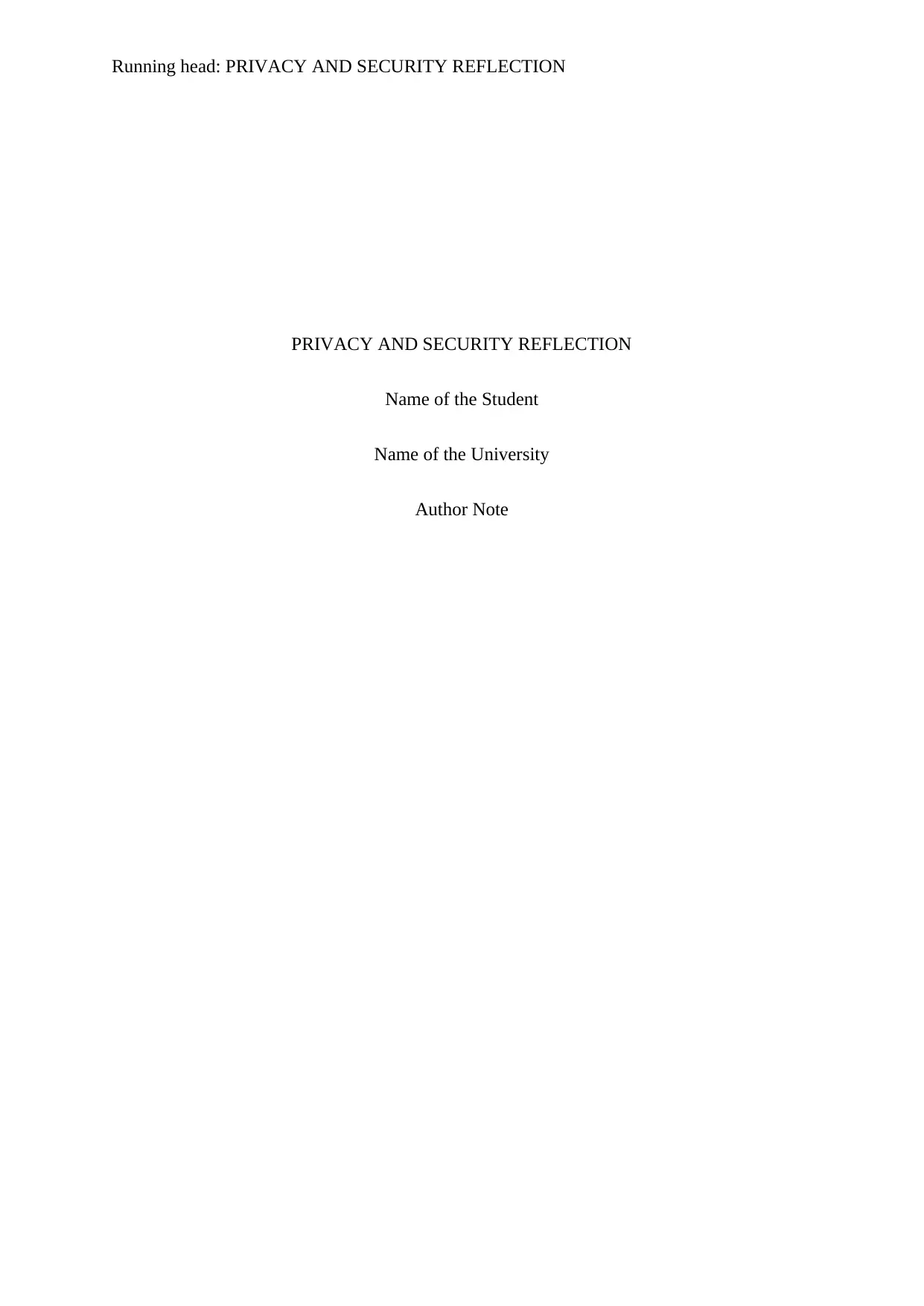
Running head: PRIVACY AND SECURITY REFLECTION
PRIVACY AND SECURITY REFLECTION
Name of the Student
Name of the University
Author Note
PRIVACY AND SECURITY REFLECTION
Name of the Student
Name of the University
Author Note
Paraphrase This Document
Need a fresh take? Get an instant paraphrase of this document with our AI Paraphraser
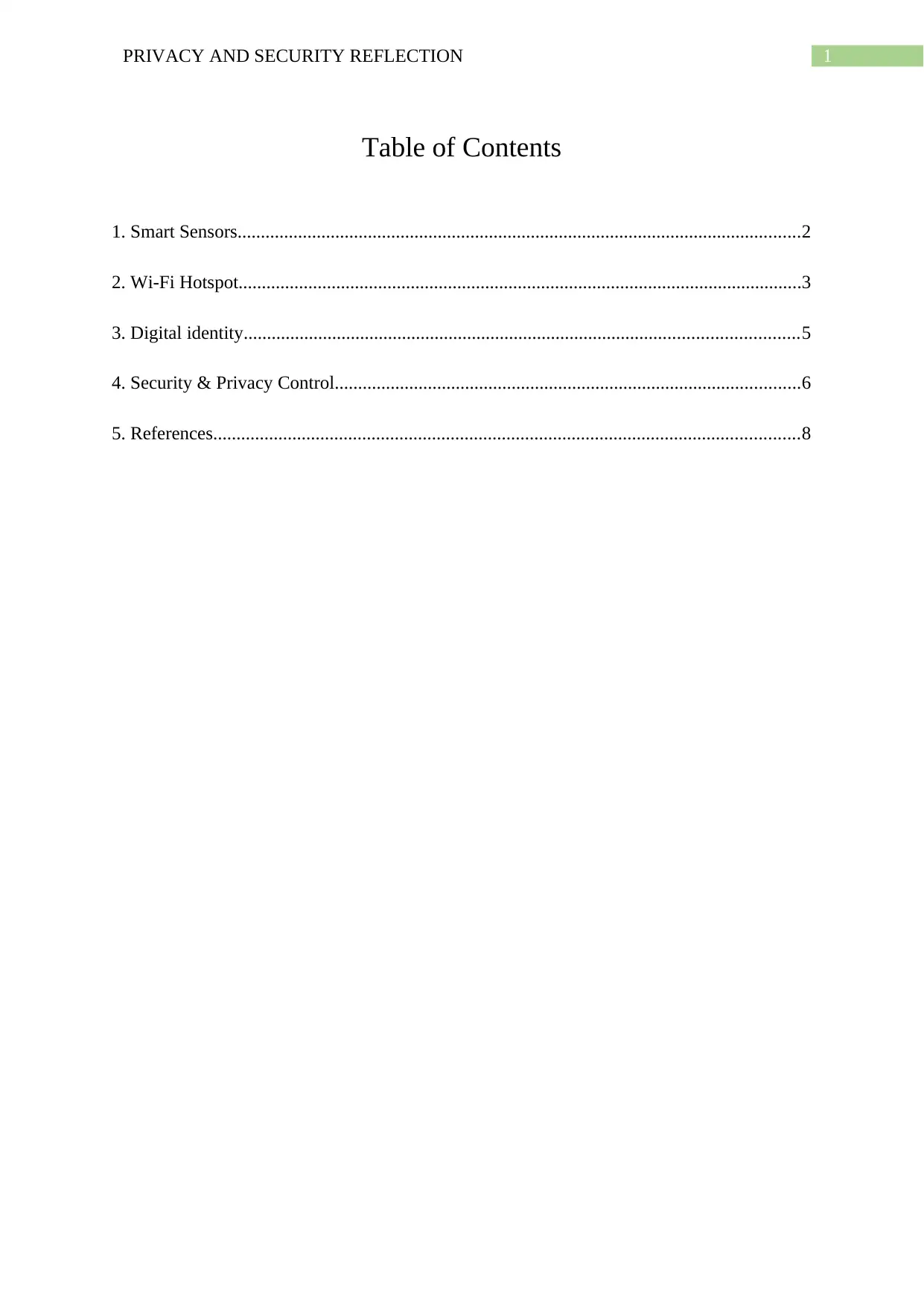
1PRIVACY AND SECURITY REFLECTION
Table of Contents
1. Smart Sensors.........................................................................................................................2
2. Wi-Fi Hotspot.........................................................................................................................3
3. Digital identity.......................................................................................................................5
4. Security & Privacy Control....................................................................................................6
5. References..............................................................................................................................8
Table of Contents
1. Smart Sensors.........................................................................................................................2
2. Wi-Fi Hotspot.........................................................................................................................3
3. Digital identity.......................................................................................................................5
4. Security & Privacy Control....................................................................................................6
5. References..............................................................................................................................8
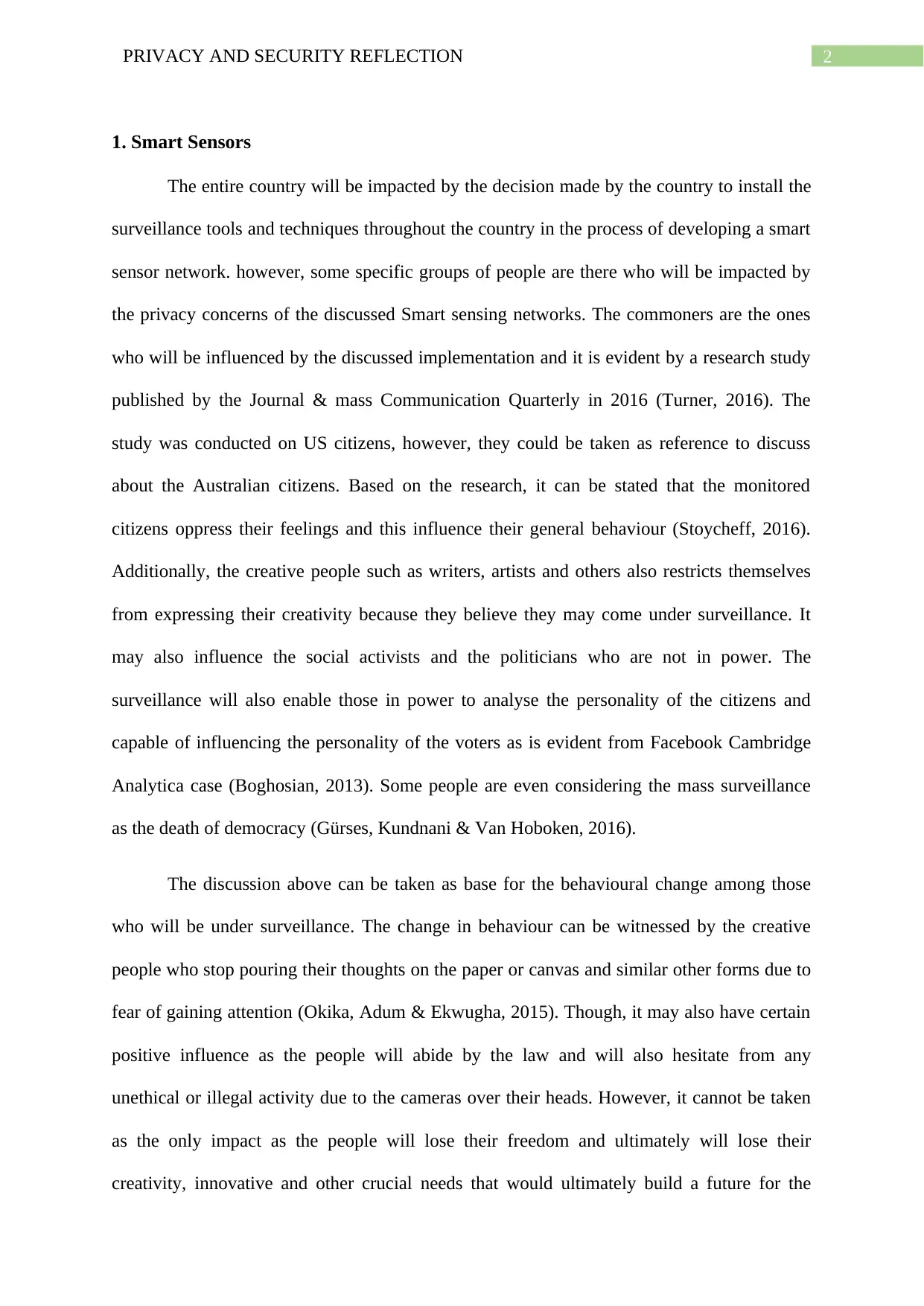
2PRIVACY AND SECURITY REFLECTION
1. Smart Sensors
The entire country will be impacted by the decision made by the country to install the
surveillance tools and techniques throughout the country in the process of developing a smart
sensor network. however, some specific groups of people are there who will be impacted by
the privacy concerns of the discussed Smart sensing networks. The commoners are the ones
who will be influenced by the discussed implementation and it is evident by a research study
published by the Journal & mass Communication Quarterly in 2016 (Turner, 2016). The
study was conducted on US citizens, however, they could be taken as reference to discuss
about the Australian citizens. Based on the research, it can be stated that the monitored
citizens oppress their feelings and this influence their general behaviour (Stoycheff, 2016).
Additionally, the creative people such as writers, artists and others also restricts themselves
from expressing their creativity because they believe they may come under surveillance. It
may also influence the social activists and the politicians who are not in power. The
surveillance will also enable those in power to analyse the personality of the citizens and
capable of influencing the personality of the voters as is evident from Facebook Cambridge
Analytica case (Boghosian, 2013). Some people are even considering the mass surveillance
as the death of democracy (Gürses, Kundnani & Van Hoboken, 2016).
The discussion above can be taken as base for the behavioural change among those
who will be under surveillance. The change in behaviour can be witnessed by the creative
people who stop pouring their thoughts on the paper or canvas and similar other forms due to
fear of gaining attention (Okika, Adum & Ekwugha, 2015). Though, it may also have certain
positive influence as the people will abide by the law and will also hesitate from any
unethical or illegal activity due to the cameras over their heads. However, it cannot be taken
as the only impact as the people will lose their freedom and ultimately will lose their
creativity, innovative and other crucial needs that would ultimately build a future for the
1. Smart Sensors
The entire country will be impacted by the decision made by the country to install the
surveillance tools and techniques throughout the country in the process of developing a smart
sensor network. however, some specific groups of people are there who will be impacted by
the privacy concerns of the discussed Smart sensing networks. The commoners are the ones
who will be influenced by the discussed implementation and it is evident by a research study
published by the Journal & mass Communication Quarterly in 2016 (Turner, 2016). The
study was conducted on US citizens, however, they could be taken as reference to discuss
about the Australian citizens. Based on the research, it can be stated that the monitored
citizens oppress their feelings and this influence their general behaviour (Stoycheff, 2016).
Additionally, the creative people such as writers, artists and others also restricts themselves
from expressing their creativity because they believe they may come under surveillance. It
may also influence the social activists and the politicians who are not in power. The
surveillance will also enable those in power to analyse the personality of the citizens and
capable of influencing the personality of the voters as is evident from Facebook Cambridge
Analytica case (Boghosian, 2013). Some people are even considering the mass surveillance
as the death of democracy (Gürses, Kundnani & Van Hoboken, 2016).
The discussion above can be taken as base for the behavioural change among those
who will be under surveillance. The change in behaviour can be witnessed by the creative
people who stop pouring their thoughts on the paper or canvas and similar other forms due to
fear of gaining attention (Okika, Adum & Ekwugha, 2015). Though, it may also have certain
positive influence as the people will abide by the law and will also hesitate from any
unethical or illegal activity due to the cameras over their heads. However, it cannot be taken
as the only impact as the people will lose their freedom and ultimately will lose their
creativity, innovative and other crucial needs that would ultimately build a future for the
⊘ This is a preview!⊘
Do you want full access?
Subscribe today to unlock all pages.

Trusted by 1+ million students worldwide
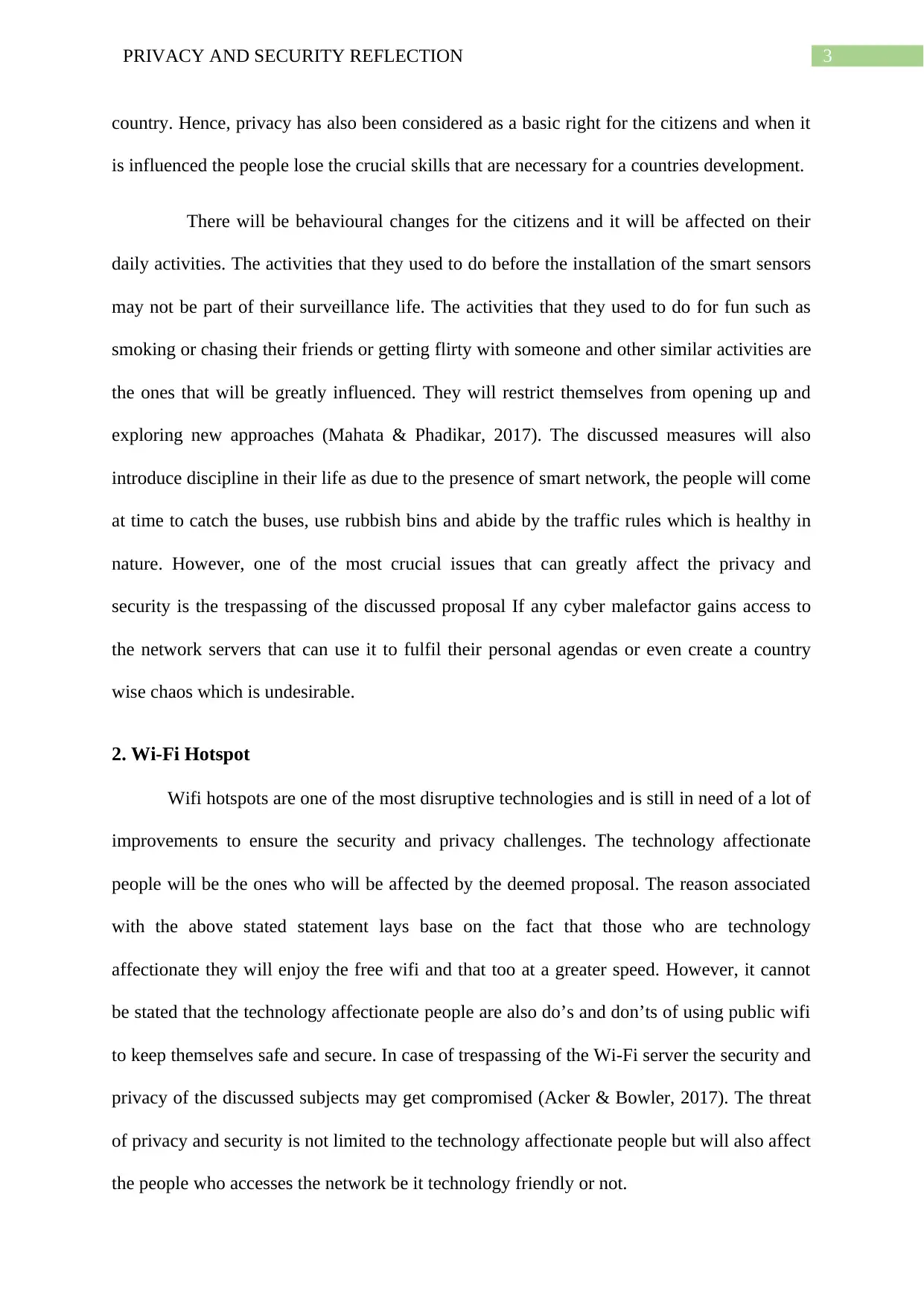
3PRIVACY AND SECURITY REFLECTION
country. Hence, privacy has also been considered as a basic right for the citizens and when it
is influenced the people lose the crucial skills that are necessary for a countries development.
There will be behavioural changes for the citizens and it will be affected on their
daily activities. The activities that they used to do before the installation of the smart sensors
may not be part of their surveillance life. The activities that they used to do for fun such as
smoking or chasing their friends or getting flirty with someone and other similar activities are
the ones that will be greatly influenced. They will restrict themselves from opening up and
exploring new approaches (Mahata & Phadikar, 2017). The discussed measures will also
introduce discipline in their life as due to the presence of smart network, the people will come
at time to catch the buses, use rubbish bins and abide by the traffic rules which is healthy in
nature. However, one of the most crucial issues that can greatly affect the privacy and
security is the trespassing of the discussed proposal If any cyber malefactor gains access to
the network servers that can use it to fulfil their personal agendas or even create a country
wise chaos which is undesirable.
2. Wi-Fi Hotspot
Wifi hotspots are one of the most disruptive technologies and is still in need of a lot of
improvements to ensure the security and privacy challenges. The technology affectionate
people will be the ones who will be affected by the deemed proposal. The reason associated
with the above stated statement lays base on the fact that those who are technology
affectionate they will enjoy the free wifi and that too at a greater speed. However, it cannot
be stated that the technology affectionate people are also do’s and don’ts of using public wifi
to keep themselves safe and secure. In case of trespassing of the Wi-Fi server the security and
privacy of the discussed subjects may get compromised (Acker & Bowler, 2017). The threat
of privacy and security is not limited to the technology affectionate people but will also affect
the people who accesses the network be it technology friendly or not.
country. Hence, privacy has also been considered as a basic right for the citizens and when it
is influenced the people lose the crucial skills that are necessary for a countries development.
There will be behavioural changes for the citizens and it will be affected on their
daily activities. The activities that they used to do before the installation of the smart sensors
may not be part of their surveillance life. The activities that they used to do for fun such as
smoking or chasing their friends or getting flirty with someone and other similar activities are
the ones that will be greatly influenced. They will restrict themselves from opening up and
exploring new approaches (Mahata & Phadikar, 2017). The discussed measures will also
introduce discipline in their life as due to the presence of smart network, the people will come
at time to catch the buses, use rubbish bins and abide by the traffic rules which is healthy in
nature. However, one of the most crucial issues that can greatly affect the privacy and
security is the trespassing of the discussed proposal If any cyber malefactor gains access to
the network servers that can use it to fulfil their personal agendas or even create a country
wise chaos which is undesirable.
2. Wi-Fi Hotspot
Wifi hotspots are one of the most disruptive technologies and is still in need of a lot of
improvements to ensure the security and privacy challenges. The technology affectionate
people will be the ones who will be affected by the deemed proposal. The reason associated
with the above stated statement lays base on the fact that those who are technology
affectionate they will enjoy the free wifi and that too at a greater speed. However, it cannot
be stated that the technology affectionate people are also do’s and don’ts of using public wifi
to keep themselves safe and secure. In case of trespassing of the Wi-Fi server the security and
privacy of the discussed subjects may get compromised (Acker & Bowler, 2017). The threat
of privacy and security is not limited to the technology affectionate people but will also affect
the people who accesses the network be it technology friendly or not.
Paraphrase This Document
Need a fresh take? Get an instant paraphrase of this document with our AI Paraphraser
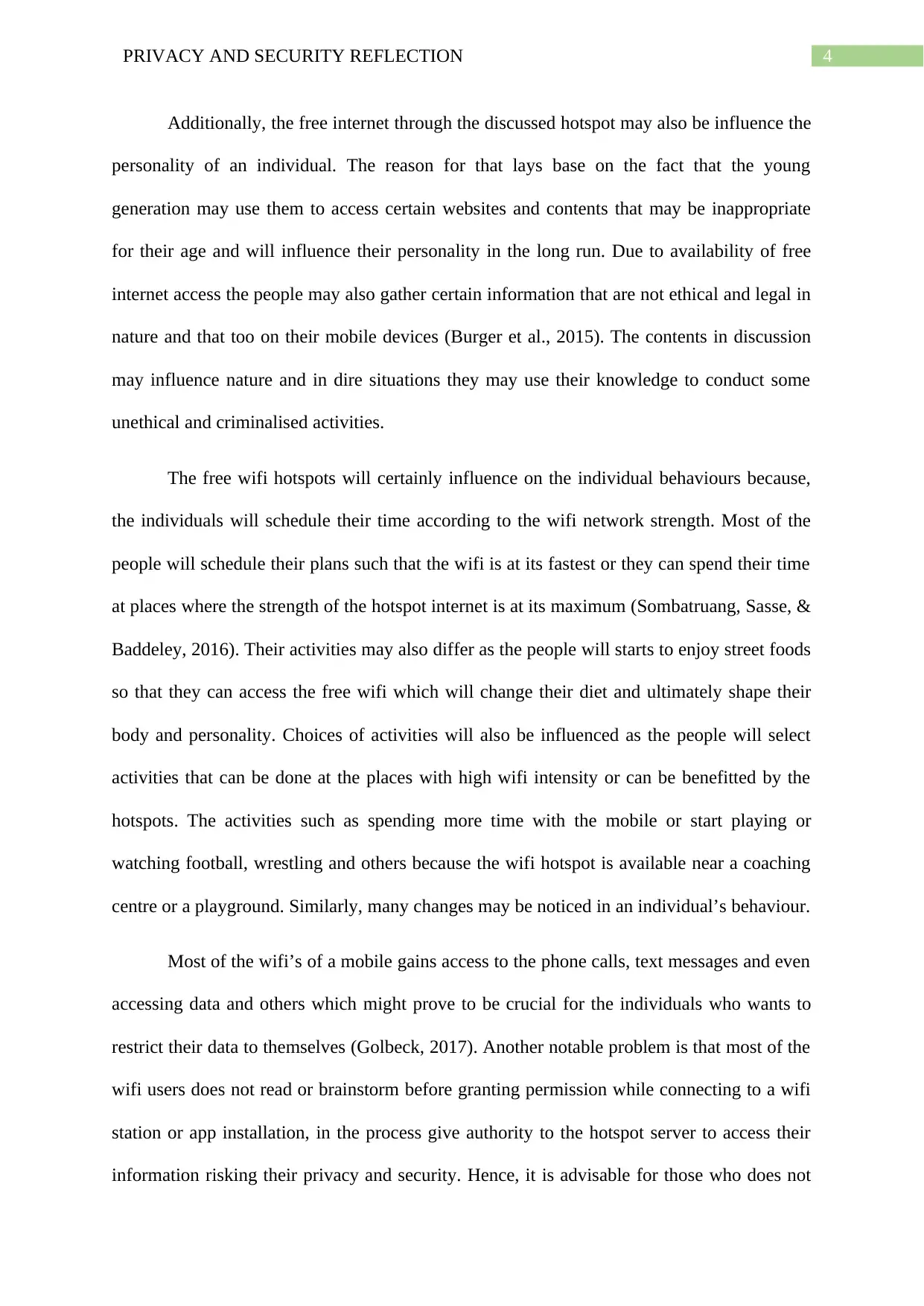
4PRIVACY AND SECURITY REFLECTION
Additionally, the free internet through the discussed hotspot may also be influence the
personality of an individual. The reason for that lays base on the fact that the young
generation may use them to access certain websites and contents that may be inappropriate
for their age and will influence their personality in the long run. Due to availability of free
internet access the people may also gather certain information that are not ethical and legal in
nature and that too on their mobile devices (Burger et al., 2015). The contents in discussion
may influence nature and in dire situations they may use their knowledge to conduct some
unethical and criminalised activities.
The free wifi hotspots will certainly influence on the individual behaviours because,
the individuals will schedule their time according to the wifi network strength. Most of the
people will schedule their plans such that the wifi is at its fastest or they can spend their time
at places where the strength of the hotspot internet is at its maximum (Sombatruang, Sasse, &
Baddeley, 2016). Their activities may also differ as the people will starts to enjoy street foods
so that they can access the free wifi which will change their diet and ultimately shape their
body and personality. Choices of activities will also be influenced as the people will select
activities that can be done at the places with high wifi intensity or can be benefitted by the
hotspots. The activities such as spending more time with the mobile or start playing or
watching football, wrestling and others because the wifi hotspot is available near a coaching
centre or a playground. Similarly, many changes may be noticed in an individual’s behaviour.
Most of the wifi’s of a mobile gains access to the phone calls, text messages and even
accessing data and others which might prove to be crucial for the individuals who wants to
restrict their data to themselves (Golbeck, 2017). Another notable problem is that most of the
wifi users does not read or brainstorm before granting permission while connecting to a wifi
station or app installation, in the process give authority to the hotspot server to access their
information risking their privacy and security. Hence, it is advisable for those who does not
Additionally, the free internet through the discussed hotspot may also be influence the
personality of an individual. The reason for that lays base on the fact that the young
generation may use them to access certain websites and contents that may be inappropriate
for their age and will influence their personality in the long run. Due to availability of free
internet access the people may also gather certain information that are not ethical and legal in
nature and that too on their mobile devices (Burger et al., 2015). The contents in discussion
may influence nature and in dire situations they may use their knowledge to conduct some
unethical and criminalised activities.
The free wifi hotspots will certainly influence on the individual behaviours because,
the individuals will schedule their time according to the wifi network strength. Most of the
people will schedule their plans such that the wifi is at its fastest or they can spend their time
at places where the strength of the hotspot internet is at its maximum (Sombatruang, Sasse, &
Baddeley, 2016). Their activities may also differ as the people will starts to enjoy street foods
so that they can access the free wifi which will change their diet and ultimately shape their
body and personality. Choices of activities will also be influenced as the people will select
activities that can be done at the places with high wifi intensity or can be benefitted by the
hotspots. The activities such as spending more time with the mobile or start playing or
watching football, wrestling and others because the wifi hotspot is available near a coaching
centre or a playground. Similarly, many changes may be noticed in an individual’s behaviour.
Most of the wifi’s of a mobile gains access to the phone calls, text messages and even
accessing data and others which might prove to be crucial for the individuals who wants to
restrict their data to themselves (Golbeck, 2017). Another notable problem is that most of the
wifi users does not read or brainstorm before granting permission while connecting to a wifi
station or app installation, in the process give authority to the hotspot server to access their
information risking their privacy and security. Hence, it is advisable for those who does not
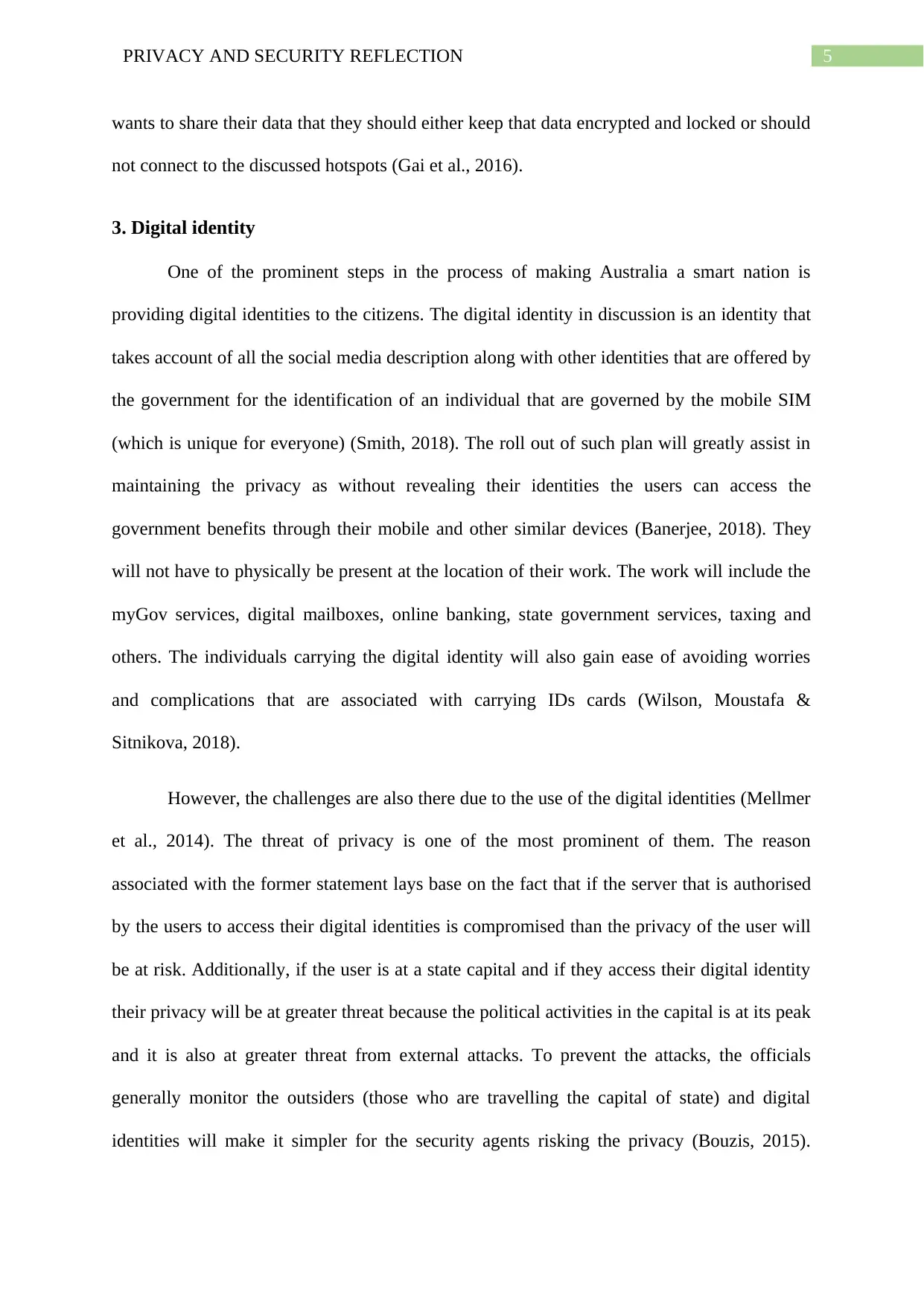
5PRIVACY AND SECURITY REFLECTION
wants to share their data that they should either keep that data encrypted and locked or should
not connect to the discussed hotspots (Gai et al., 2016).
3. Digital identity
One of the prominent steps in the process of making Australia a smart nation is
providing digital identities to the citizens. The digital identity in discussion is an identity that
takes account of all the social media description along with other identities that are offered by
the government for the identification of an individual that are governed by the mobile SIM
(which is unique for everyone) (Smith, 2018). The roll out of such plan will greatly assist in
maintaining the privacy as without revealing their identities the users can access the
government benefits through their mobile and other similar devices (Banerjee, 2018). They
will not have to physically be present at the location of their work. The work will include the
myGov services, digital mailboxes, online banking, state government services, taxing and
others. The individuals carrying the digital identity will also gain ease of avoiding worries
and complications that are associated with carrying IDs cards (Wilson, Moustafa &
Sitnikova, 2018).
However, the challenges are also there due to the use of the digital identities (Mellmer
et al., 2014). The threat of privacy is one of the most prominent of them. The reason
associated with the former statement lays base on the fact that if the server that is authorised
by the users to access their digital identities is compromised than the privacy of the user will
be at risk. Additionally, if the user is at a state capital and if they access their digital identity
their privacy will be at greater threat because the political activities in the capital is at its peak
and it is also at greater threat from external attacks. To prevent the attacks, the officials
generally monitor the outsiders (those who are travelling the capital of state) and digital
identities will make it simpler for the security agents risking the privacy (Bouzis, 2015).
wants to share their data that they should either keep that data encrypted and locked or should
not connect to the discussed hotspots (Gai et al., 2016).
3. Digital identity
One of the prominent steps in the process of making Australia a smart nation is
providing digital identities to the citizens. The digital identity in discussion is an identity that
takes account of all the social media description along with other identities that are offered by
the government for the identification of an individual that are governed by the mobile SIM
(which is unique for everyone) (Smith, 2018). The roll out of such plan will greatly assist in
maintaining the privacy as without revealing their identities the users can access the
government benefits through their mobile and other similar devices (Banerjee, 2018). They
will not have to physically be present at the location of their work. The work will include the
myGov services, digital mailboxes, online banking, state government services, taxing and
others. The individuals carrying the digital identity will also gain ease of avoiding worries
and complications that are associated with carrying IDs cards (Wilson, Moustafa &
Sitnikova, 2018).
However, the challenges are also there due to the use of the digital identities (Mellmer
et al., 2014). The threat of privacy is one of the most prominent of them. The reason
associated with the former statement lays base on the fact that if the server that is authorised
by the users to access their digital identities is compromised than the privacy of the user will
be at risk. Additionally, if the user is at a state capital and if they access their digital identity
their privacy will be at greater threat because the political activities in the capital is at its peak
and it is also at greater threat from external attacks. To prevent the attacks, the officials
generally monitor the outsiders (those who are travelling the capital of state) and digital
identities will make it simpler for the security agents risking the privacy (Bouzis, 2015).
⊘ This is a preview!⊘
Do you want full access?
Subscribe today to unlock all pages.

Trusted by 1+ million students worldwide
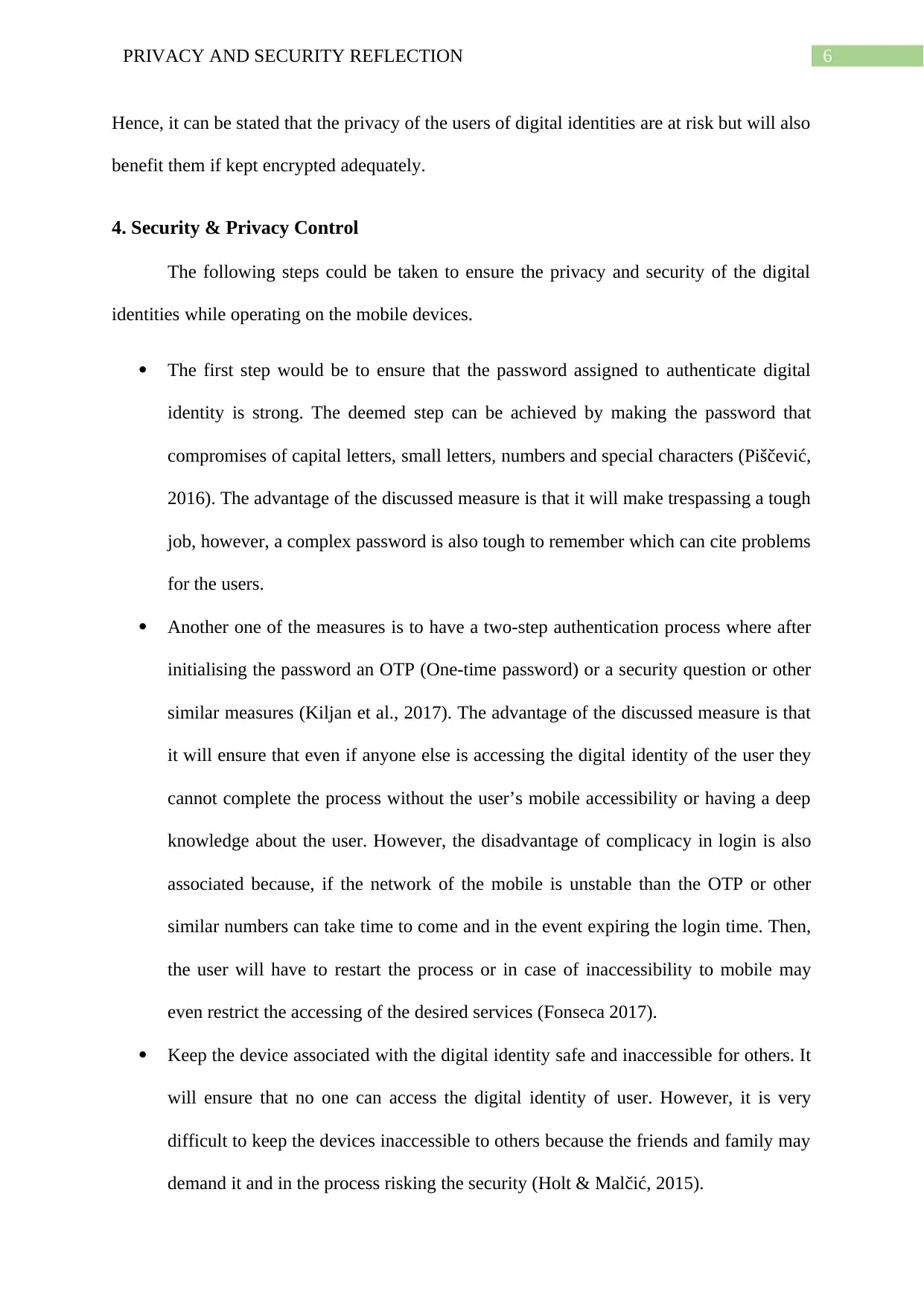
6PRIVACY AND SECURITY REFLECTION
Hence, it can be stated that the privacy of the users of digital identities are at risk but will also
benefit them if kept encrypted adequately.
4. Security & Privacy Control
The following steps could be taken to ensure the privacy and security of the digital
identities while operating on the mobile devices.
The first step would be to ensure that the password assigned to authenticate digital
identity is strong. The deemed step can be achieved by making the password that
compromises of capital letters, small letters, numbers and special characters (Piščević,
2016). The advantage of the discussed measure is that it will make trespassing a tough
job, however, a complex password is also tough to remember which can cite problems
for the users.
Another one of the measures is to have a two-step authentication process where after
initialising the password an OTP (One-time password) or a security question or other
similar measures (Kiljan et al., 2017). The advantage of the discussed measure is that
it will ensure that even if anyone else is accessing the digital identity of the user they
cannot complete the process without the user’s mobile accessibility or having a deep
knowledge about the user. However, the disadvantage of complicacy in login is also
associated because, if the network of the mobile is unstable than the OTP or other
similar numbers can take time to come and in the event expiring the login time. Then,
the user will have to restart the process or in case of inaccessibility to mobile may
even restrict the accessing of the desired services (Fonseca 2017).
Keep the device associated with the digital identity safe and inaccessible for others. It
will ensure that no one can access the digital identity of user. However, it is very
difficult to keep the devices inaccessible to others because the friends and family may
demand it and in the process risking the security (Holt & Malčić, 2015).
Hence, it can be stated that the privacy of the users of digital identities are at risk but will also
benefit them if kept encrypted adequately.
4. Security & Privacy Control
The following steps could be taken to ensure the privacy and security of the digital
identities while operating on the mobile devices.
The first step would be to ensure that the password assigned to authenticate digital
identity is strong. The deemed step can be achieved by making the password that
compromises of capital letters, small letters, numbers and special characters (Piščević,
2016). The advantage of the discussed measure is that it will make trespassing a tough
job, however, a complex password is also tough to remember which can cite problems
for the users.
Another one of the measures is to have a two-step authentication process where after
initialising the password an OTP (One-time password) or a security question or other
similar measures (Kiljan et al., 2017). The advantage of the discussed measure is that
it will ensure that even if anyone else is accessing the digital identity of the user they
cannot complete the process without the user’s mobile accessibility or having a deep
knowledge about the user. However, the disadvantage of complicacy in login is also
associated because, if the network of the mobile is unstable than the OTP or other
similar numbers can take time to come and in the event expiring the login time. Then,
the user will have to restart the process or in case of inaccessibility to mobile may
even restrict the accessing of the desired services (Fonseca 2017).
Keep the device associated with the digital identity safe and inaccessible for others. It
will ensure that no one can access the digital identity of user. However, it is very
difficult to keep the devices inaccessible to others because the friends and family may
demand it and in the process risking the security (Holt & Malčić, 2015).
Paraphrase This Document
Need a fresh take? Get an instant paraphrase of this document with our AI Paraphraser

7PRIVACY AND SECURITY REFLECTION
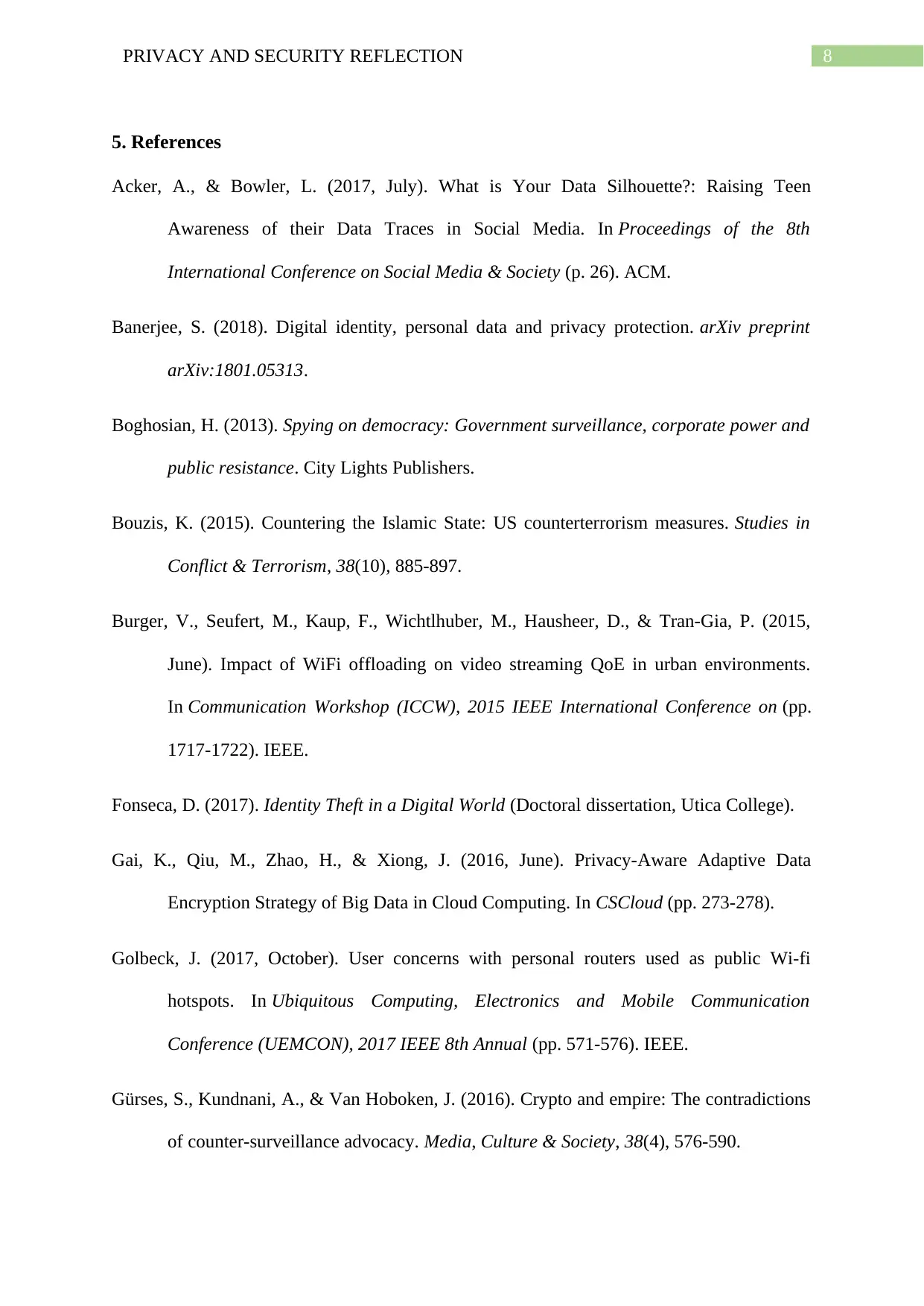
8PRIVACY AND SECURITY REFLECTION
5. References
Acker, A., & Bowler, L. (2017, July). What is Your Data Silhouette?: Raising Teen
Awareness of their Data Traces in Social Media. In Proceedings of the 8th
International Conference on Social Media & Society (p. 26). ACM.
Banerjee, S. (2018). Digital identity, personal data and privacy protection. arXiv preprint
arXiv:1801.05313.
Boghosian, H. (2013). Spying on democracy: Government surveillance, corporate power and
public resistance. City Lights Publishers.
Bouzis, K. (2015). Countering the Islamic State: US counterterrorism measures. Studies in
Conflict & Terrorism, 38(10), 885-897.
Burger, V., Seufert, M., Kaup, F., Wichtlhuber, M., Hausheer, D., & Tran-Gia, P. (2015,
June). Impact of WiFi offloading on video streaming QoE in urban environments.
In Communication Workshop (ICCW), 2015 IEEE International Conference on (pp.
1717-1722). IEEE.
Fonseca, D. (2017). Identity Theft in a Digital World (Doctoral dissertation, Utica College).
Gai, K., Qiu, M., Zhao, H., & Xiong, J. (2016, June). Privacy-Aware Adaptive Data
Encryption Strategy of Big Data in Cloud Computing. In CSCloud (pp. 273-278).
Golbeck, J. (2017, October). User concerns with personal routers used as public Wi-fi
hotspots. In Ubiquitous Computing, Electronics and Mobile Communication
Conference (UEMCON), 2017 IEEE 8th Annual (pp. 571-576). IEEE.
Gürses, S., Kundnani, A., & Van Hoboken, J. (2016). Crypto and empire: The contradictions
of counter-surveillance advocacy. Media, Culture & Society, 38(4), 576-590.
5. References
Acker, A., & Bowler, L. (2017, July). What is Your Data Silhouette?: Raising Teen
Awareness of their Data Traces in Social Media. In Proceedings of the 8th
International Conference on Social Media & Society (p. 26). ACM.
Banerjee, S. (2018). Digital identity, personal data and privacy protection. arXiv preprint
arXiv:1801.05313.
Boghosian, H. (2013). Spying on democracy: Government surveillance, corporate power and
public resistance. City Lights Publishers.
Bouzis, K. (2015). Countering the Islamic State: US counterterrorism measures. Studies in
Conflict & Terrorism, 38(10), 885-897.
Burger, V., Seufert, M., Kaup, F., Wichtlhuber, M., Hausheer, D., & Tran-Gia, P. (2015,
June). Impact of WiFi offloading on video streaming QoE in urban environments.
In Communication Workshop (ICCW), 2015 IEEE International Conference on (pp.
1717-1722). IEEE.
Fonseca, D. (2017). Identity Theft in a Digital World (Doctoral dissertation, Utica College).
Gai, K., Qiu, M., Zhao, H., & Xiong, J. (2016, June). Privacy-Aware Adaptive Data
Encryption Strategy of Big Data in Cloud Computing. In CSCloud (pp. 273-278).
Golbeck, J. (2017, October). User concerns with personal routers used as public Wi-fi
hotspots. In Ubiquitous Computing, Electronics and Mobile Communication
Conference (UEMCON), 2017 IEEE 8th Annual (pp. 571-576). IEEE.
Gürses, S., Kundnani, A., & Van Hoboken, J. (2016). Crypto and empire: The contradictions
of counter-surveillance advocacy. Media, Culture & Society, 38(4), 576-590.
⊘ This is a preview!⊘
Do you want full access?
Subscribe today to unlock all pages.

Trusted by 1+ million students worldwide
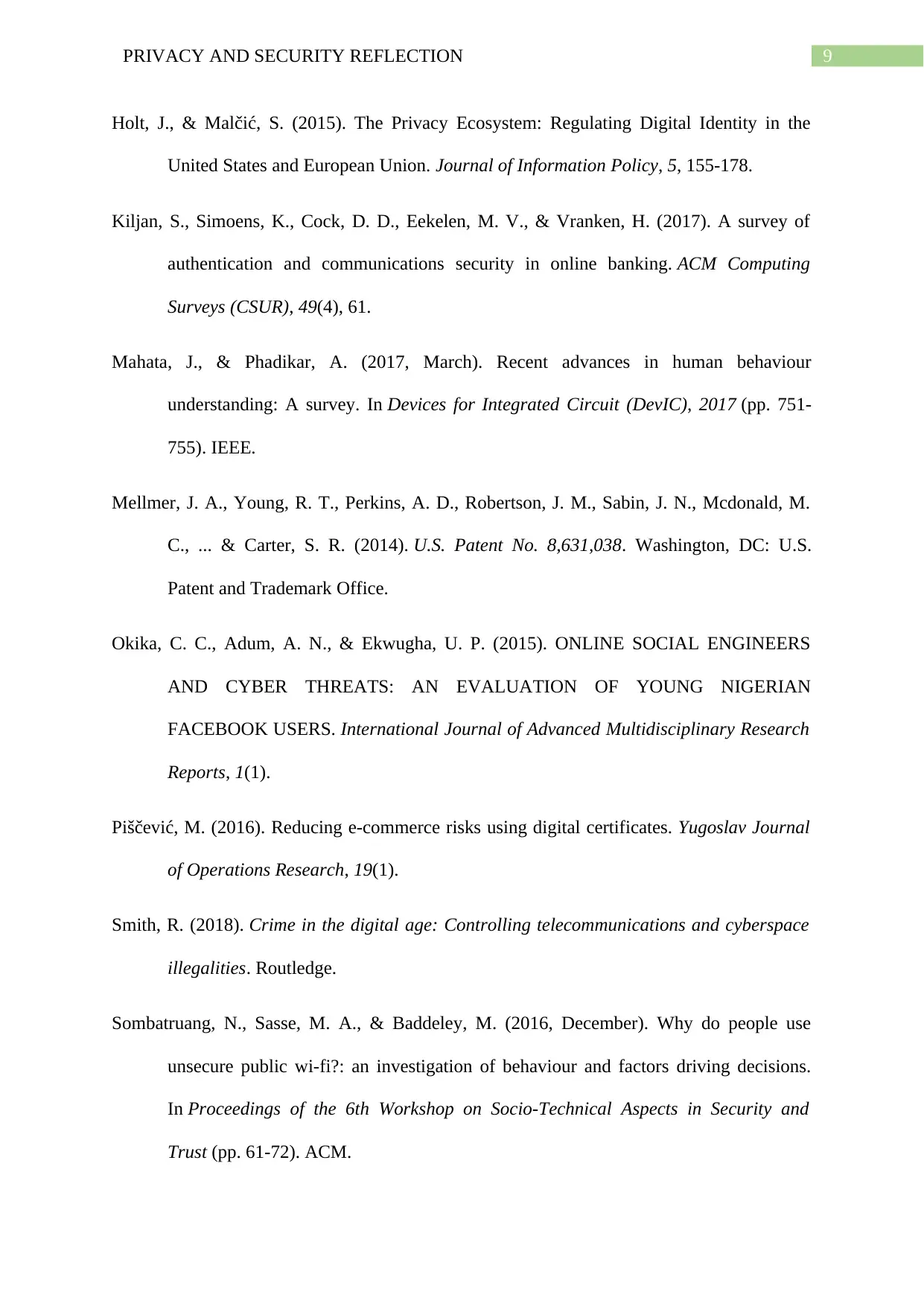
9PRIVACY AND SECURITY REFLECTION
Holt, J., & Malčić, S. (2015). The Privacy Ecosystem: Regulating Digital Identity in the
United States and European Union. Journal of Information Policy, 5, 155-178.
Kiljan, S., Simoens, K., Cock, D. D., Eekelen, M. V., & Vranken, H. (2017). A survey of
authentication and communications security in online banking. ACM Computing
Surveys (CSUR), 49(4), 61.
Mahata, J., & Phadikar, A. (2017, March). Recent advances in human behaviour
understanding: A survey. In Devices for Integrated Circuit (DevIC), 2017 (pp. 751-
755). IEEE.
Mellmer, J. A., Young, R. T., Perkins, A. D., Robertson, J. M., Sabin, J. N., Mcdonald, M.
C., ... & Carter, S. R. (2014). U.S. Patent No. 8,631,038. Washington, DC: U.S.
Patent and Trademark Office.
Okika, C. C., Adum, A. N., & Ekwugha, U. P. (2015). ONLINE SOCIAL ENGINEERS
AND CYBER THREATS: AN EVALUATION OF YOUNG NIGERIAN
FACEBOOK USERS. International Journal of Advanced Multidisciplinary Research
Reports, 1(1).
Piščević, M. (2016). Reducing e-commerce risks using digital certificates. Yugoslav Journal
of Operations Research, 19(1).
Smith, R. (2018). Crime in the digital age: Controlling telecommunications and cyberspace
illegalities. Routledge.
Sombatruang, N., Sasse, M. A., & Baddeley, M. (2016, December). Why do people use
unsecure public wi-fi?: an investigation of behaviour and factors driving decisions.
In Proceedings of the 6th Workshop on Socio-Technical Aspects in Security and
Trust (pp. 61-72). ACM.
Holt, J., & Malčić, S. (2015). The Privacy Ecosystem: Regulating Digital Identity in the
United States and European Union. Journal of Information Policy, 5, 155-178.
Kiljan, S., Simoens, K., Cock, D. D., Eekelen, M. V., & Vranken, H. (2017). A survey of
authentication and communications security in online banking. ACM Computing
Surveys (CSUR), 49(4), 61.
Mahata, J., & Phadikar, A. (2017, March). Recent advances in human behaviour
understanding: A survey. In Devices for Integrated Circuit (DevIC), 2017 (pp. 751-
755). IEEE.
Mellmer, J. A., Young, R. T., Perkins, A. D., Robertson, J. M., Sabin, J. N., Mcdonald, M.
C., ... & Carter, S. R. (2014). U.S. Patent No. 8,631,038. Washington, DC: U.S.
Patent and Trademark Office.
Okika, C. C., Adum, A. N., & Ekwugha, U. P. (2015). ONLINE SOCIAL ENGINEERS
AND CYBER THREATS: AN EVALUATION OF YOUNG NIGERIAN
FACEBOOK USERS. International Journal of Advanced Multidisciplinary Research
Reports, 1(1).
Piščević, M. (2016). Reducing e-commerce risks using digital certificates. Yugoslav Journal
of Operations Research, 19(1).
Smith, R. (2018). Crime in the digital age: Controlling telecommunications and cyberspace
illegalities. Routledge.
Sombatruang, N., Sasse, M. A., & Baddeley, M. (2016, December). Why do people use
unsecure public wi-fi?: an investigation of behaviour and factors driving decisions.
In Proceedings of the 6th Workshop on Socio-Technical Aspects in Security and
Trust (pp. 61-72). ACM.
Paraphrase This Document
Need a fresh take? Get an instant paraphrase of this document with our AI Paraphraser
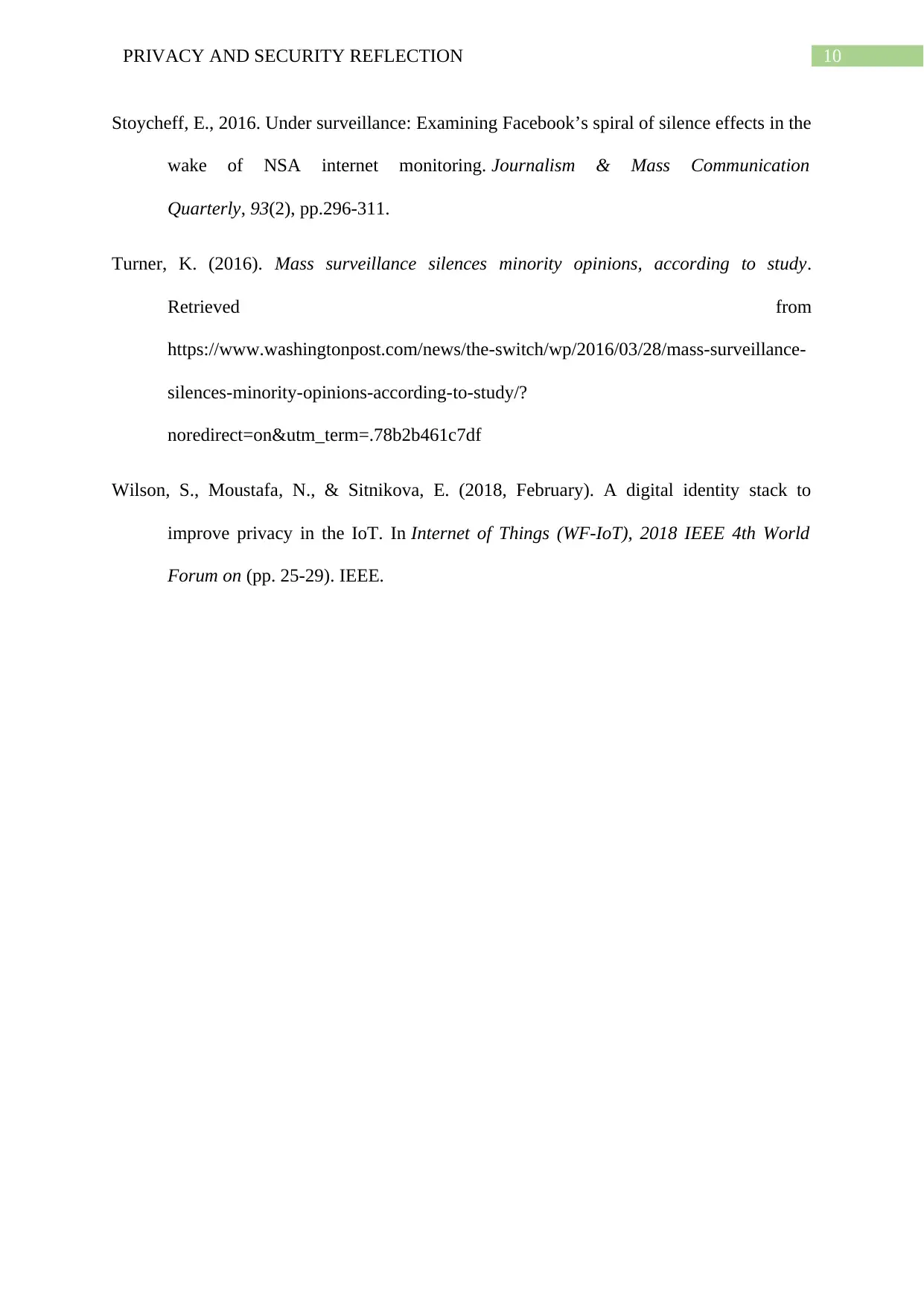
10PRIVACY AND SECURITY REFLECTION
Stoycheff, E., 2016. Under surveillance: Examining Facebook’s spiral of silence effects in the
wake of NSA internet monitoring. Journalism & Mass Communication
Quarterly, 93(2), pp.296-311.
Turner, K. (2016). Mass surveillance silences minority opinions, according to study.
Retrieved from
https://www.washingtonpost.com/news/the-switch/wp/2016/03/28/mass-surveillance-
silences-minority-opinions-according-to-study/?
noredirect=on&utm_term=.78b2b461c7df
Wilson, S., Moustafa, N., & Sitnikova, E. (2018, February). A digital identity stack to
improve privacy in the IoT. In Internet of Things (WF-IoT), 2018 IEEE 4th World
Forum on (pp. 25-29). IEEE.
Stoycheff, E., 2016. Under surveillance: Examining Facebook’s spiral of silence effects in the
wake of NSA internet monitoring. Journalism & Mass Communication
Quarterly, 93(2), pp.296-311.
Turner, K. (2016). Mass surveillance silences minority opinions, according to study.
Retrieved from
https://www.washingtonpost.com/news/the-switch/wp/2016/03/28/mass-surveillance-
silences-minority-opinions-according-to-study/?
noredirect=on&utm_term=.78b2b461c7df
Wilson, S., Moustafa, N., & Sitnikova, E. (2018, February). A digital identity stack to
improve privacy in the IoT. In Internet of Things (WF-IoT), 2018 IEEE 4th World
Forum on (pp. 25-29). IEEE.
1 out of 11
Related Documents
Your All-in-One AI-Powered Toolkit for Academic Success.
+13062052269
info@desklib.com
Available 24*7 on WhatsApp / Email
![[object Object]](/_next/static/media/star-bottom.7253800d.svg)
Unlock your academic potential
Copyright © 2020–2025 A2Z Services. All Rights Reserved. Developed and managed by ZUCOL.



